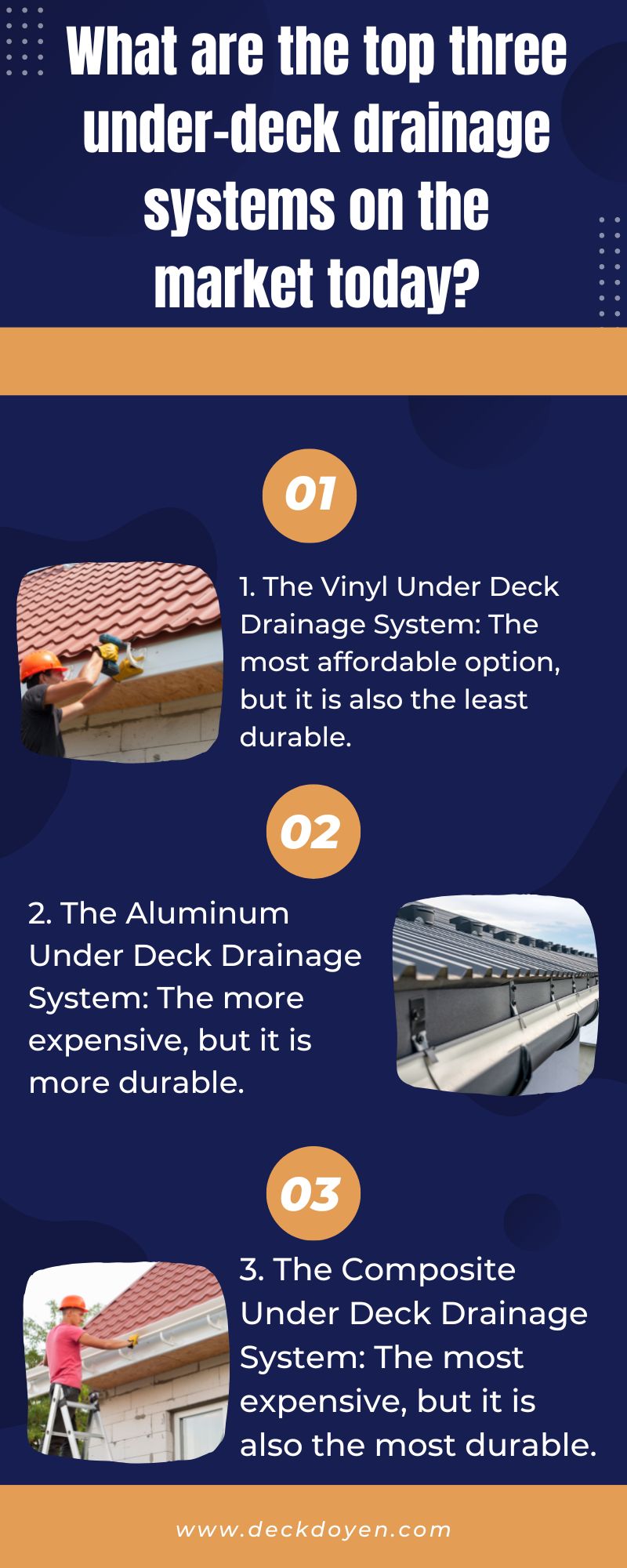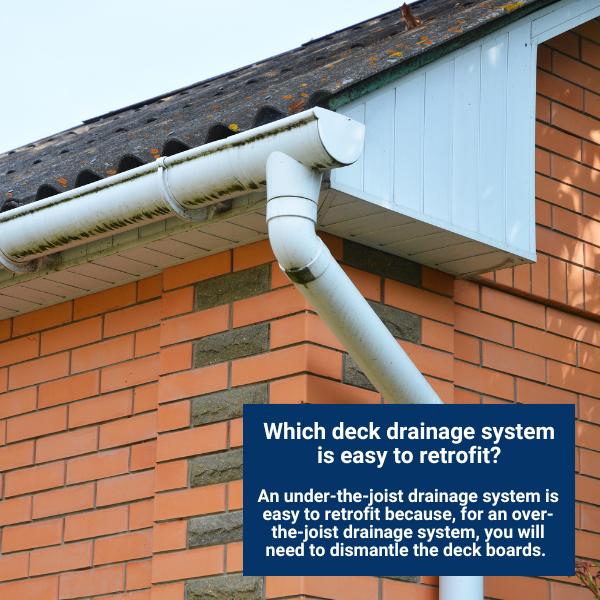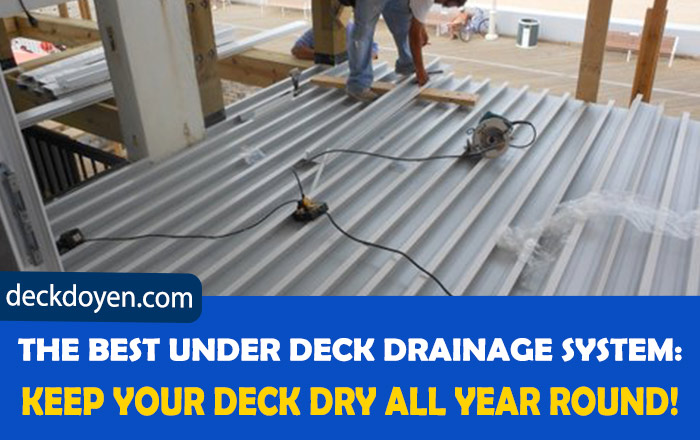When constructing a new deck for your house, consider installing a drainage system under your deck to maximize the return for your expense. Protecting your deck foundation from water may create a drier, useable space beneath a floating hardwood deck. Therefore many people want to know what is the best deck drainage system.
The best under-deck drainage system is the one that is easy to install and does not require dismantling the deck. It should also be able to protect the joists and columns from dampness while also keeping fasteners in place longer. If you’re constructing a new deck, an over-the-joist system is the better option. If you’re retrofitting an existing deck, a below-the-joist system may be easier to install.
A deck drainage system has many benefits, but it’s critical to install the one that fits your needs. So, let’s get to know everything about the under-deck drainage system.
The Best Under Deck Drainage System: Keep Your Space Dry And Functional!
There are a few things to consider when choosing the best under-deck drainage system for your needs.
Also Read: How To Lay Decking On Grass? Step By Step Guide!
- First, you’ll want to decide what type of system will work best for your particular deck setup. There are systems that can be installed underneath the joists and others that attach to the ledger board.
- Second, you’ll need to consider what kind of material you want the system to be made out of. There are systems made out of plastic, aluminum, and even PVC.
- Third, you’ll need to decide how much water you want the system to be able to drain. Some systems can handle up to 60 gallons per minute, while others are only rated for 10 or 20 gallons per minute.

- Fourth, you’ll need to consider the climate in your area. If you live in an area with a lot of rainfall, you’ll want to make sure that the system you choose can handle the amount of water that could potentially come through.
- Finally, you’ll want to consider the warranty that comes with the system. Some manufacturers offer lifetime warranties, while others only offer a few years.
With so many things to consider, it’s important to do your research before making a final decision. The best under-deck drainage system for you will ultimately depend on your specific needs and preferences.
Here’s an in-depth overview of the two types of under-deck drainage systems:
Also Read: Best Wood For Decking: Which One To Choose And Why?
Below-The-Joist Deck Drainage System:
The below joist under deck drainage system is designed by installing metal or sturdy vinyl pieces beneath the joists. They build a slant surface to transfer water to a drain pipe linked to the ridge of the deck beam, which then conducts the water to the main drainage line. It’s easier and more inexpensive. If you install a deck drainage system under the joists, water will drip through the wooden planks, across the joists, and pool in the sewage system.
Because you don’t need to take the deck apart for installation, below-deck joint drainage is an excellent method to retrofit. However, there are several other disadvantages of below the joist deck drainage system.
Drawbacks Under The Joist Deck Drainage System:
- It permits water to repeatedly soak the wood as it drops through the deck planks, over the joists, and down into the drainage system. The water enters the pan and drains while soaking the joists. When the joists are continually damp, they will decay.
- This type of deck drainage system retains moisture. There is no air flowing to dry the hardwood if there is a roof below the deck. The only way to get air is through the quarter-inch gap between the top deck planks.
- The further heat fries this entrapped, moist wood during the warmer summer months, hastening the wood’s decaying process.

Over-The-Joist Deck Drainage System:
If you go for an over-the-joist system, you will place the drainage lines above the joists so that moisture never enters the joists and beams. Above-joist drainage systems include a network of drains draped between the joists and the wooden planks consisting of a waterproof substance such as latex, PVC or rubber. When water seeps through the gaps between deck planks, the drainage lines gather it and direct it towards the deck’s outside border, where it pours into a gutter that directs the water to the main drainage line.
Also Read: Should A Deck Be Level Or Sloped? Detailed Answer!
A deck drainage system above the joists is the best because It will protect all joists and columns from dampness due to water dripping. An above-the-joist system keeps fasteners in place longer by acting as a barrier between galvanized metal and wood.
However, an above-joist under-deck drainage system is challenging to install. Therefore it is a better option for a new deck building. Installing an above-joist system to an existing deck necessitates dismantling all decking and replacing it once you install the complete drainage network. So, If you’re constructing the new deck alone, go with an over-the-joist solution. It will aid your deck foundation to survive for a long time.
Why Should You Install Deck Drainage System:
A deck drainage system is necessary to maintain the deck unchanged for years. It has several benefits, which are as follows.
- It protects the deck wood from rotting due to moisture as it keeps the wood dry.
- It also minimizes the chance of moss and algae growth due to damp wood.
- It prevents deck flooding with water in case of heavy downpours.
- A good under-deck drainage system allows you to use your space below the deck for any useful purpose keeping it dry even in the rain.
- The Deck drainage system maintains waterproofing for safe electric and gas fitting under your deck.
- It’s inexpensive and easy to install as you can buy a deck drainage kit and install it at home.

How To Install A Deck Drainage System:
To install a deck drainage system:
- First, follow the setup guidelines to waterproof the area beneath your decking.
- Next, downspouts are installed along the joists, and a vent is placed within every joist slot at the border joist.
- Then, drain panels are attached along the length of the deck, with one end flush with the joist border.
- After that, a gutter is installed along the length of the deck to catch the water runoff.
- Finally, the decking is attached using concealed fasteners.
Also Read: Cheapest Ways To Build A Deck In 2022
Final Thought!
The drainage system you select for your under-deck depends on what you hope to achieve and your personal preferences. If you are installing a new deck by yourself, go with an over-the-joist solution. Your deck’s foundation will last longer that way. But if you want a less expensive and simpler option, choose below-the-joist instead. Just be sure to do your homework regardless of which route you ultimately decide upon so that the product is worth the money. Lastly, ensure to install it cautiously for the best possible results.

